For years, football enthusiasts have grappled with the ever-evolving landscape of their beloved sport. As cultural norms shift, so does the presentation of major events like the World Cup, edging closer to the spectacle-driven models of American sports. In this melee of commercialism, FIFA’s choice to inject a Super Bowl-inspired halftime show into the 2026 World Cup final raises eyebrows and ignites debates. Are we compromising the sanctity of the game for a few more bucks? To many, the answer is painfully clear: Yes.
Football has traditionally thrived on its simplicity, where the focus remains staunchly on the game itself. However, the commercial lure of halftime extravaganzas designed to attract a broader audience seems to overshadow this fundamental truth. The allure of pop stars and celebrity performances seems more about fostering a fleeting attention span than enriching the footballing experience, which raises the stakes of an important question: Are we sacrificing the essence of the sport in pursuit of profit?
The Misguided Push for Inclusivity
FIFA’s intent behind orchestrating a grand halftime show is ostensibly to appeal to the masses—creating a carnival atmosphere that entices fans who might not typically tune in for a match. But therein lies a critical flaw: the assumption that entertaining interludes will organically convert casual viewers into diehard fans. Historical examples, particularly the halcyon days of football’s glorious past, suggest that purity, not spectacle, is the catalyst for loyalty.
For a genuine football fan, a performance by Taylor Swift or Drake may not enhance the viewing experience at all. In fact, for some, it serves as a distraction from the thrill of high-stakes competition unfolding on the pitch. This obsession with bombastic entertainment is something our sport does not require, especially considering that committed fans prioritize the beauty, drama, and unpredictability found in an unfolding match. Catering to an audience that only occasionally dips into the world of football feels like a debilitating compromise that risks alienating the very core of what makes the game grand.
FIFA’s Corporate Culture: A Cause for Concern
The overarching trend of commercialization is not exclusive to FIFA; it permeates the sporting world. However, a closer examination reveals a troubling pattern in FIFA’s approach as they pursue rampant revenue growth. The skepticism surrounding FIFA’s financial ethics leads one to question whether the overarching drive for profits has tarnished the game’s integrity. Who, after all, stands to benefit?
National associations, presumably the shareholders, endorse their leadership based on profitability rather than passion for the sport. While financial support for less developed football nations sounds great on paper, the questionable dissemination of funds raises red flags. Despite evidence of mismanagement, FIFA’s relentless pursuit of financial gain shows little regard for the beautiful game itself. It’s a vicious cycle where the authenticity of competition is sacrificed in favor of balance sheets.
The Importance of Structure: A Hard Rule
Nevertheless, amidst all these calculated distractions, FIFA must be acutely aware of one salient rule: halftime cannot exceed 15 minutes. The foundation of this regulation goes beyond merely preserving tradition. Athletes are scientifically conditioned to perform within specific parameters, and extending breaks could alter the rhythm and momentum crucial to the match’s flow.
Recent indiscretions regarding lengthy halftime pauses, like the one during the 2024 Copa America final, only underscore the risk involved in tampering with this basic tenet. Players must return to the pitch invigorated, not frozen or stiffened by unnecessary delays. Perhaps, if FIFA insists on a halftime spectacle, the structure must impeccably adhere to this timeframe to preserve the competitive fabric of the sport. Showcases are all good and well, but they must be facilitated without disrupting the essential dynamics of the game.
Finding the Balance Between Tradition and Spectacle
As we stand at the crossroads of tradition and modernity, it’s imperative that FIFA finds a harmonious balance. Creating an entertainment segment that respects the time constraints while delivering a taste of fun may not be entirely impossible. If a 15-minute extravaganza can be crafted without displacing the essence of the sport, then perhaps embracing change could yield a win-win system of sorts.
Yet, if FIFA allows the allure of pizzazz to balloon out of control, they must confront the backlash from loyal fans unwilling to forsake the pure competition for a smattering of celebrity. The stakes are high, and any decisions made in the boardroom must take into account the rich tapestry that defines football’s enduring allure. In the quest for progress, the preservation of the game’s integrity must remain paramount—anything less would be an injustice to the sport itself.

